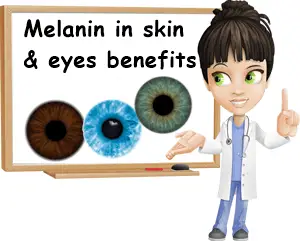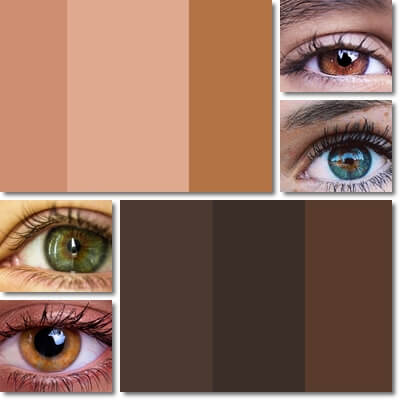Melanin is a pigment produced by special cells called melanocytes. It’s best know for giving skin its color and is responsible for the darkest all the way to the lightest skin tones. It’s also what gives our eyes their color and it’s found in the brain, inner ear, hair and lips too. Just as interesting, it both initiates and wholly determines how our skin tans as a result of sunlight exposure, whether that means picking up a gorgeous tan fast or getting sunburns and blisters and little to no tan at all. Read more to find out the most interesting 11 scientific facts about the skin pigment melanin.
1) Melanin absorbs sunlight UV radiation
Believe it or not, sunlight gets absorbed into the skin. But it doesn’t go further than the outermost layer of the skin, the epidermis. There, at the bottom of the epidermis, lie cells called melanocytes that produce the pigment called melanin in response to sunlight exposure. The pigment melanin essentially contains UV radiation from sunlight and prevents cellular damage caused by it.

2) Melanin dissipates UVA and UVB radiation
Sunlight contains UVA and UVB radiation which can damage skin, causing premature aging and increasing the risk for skin cancer.
But melanin catches sunlight radiation and dissipates said radiation, preventing damage to the skin, or at least limiting it. The pigment essentially has photoprotective benefits meaning it protects against damage from sunlight radiation.
Of course, its photoprotective properties are not 100% effective. But typically, the darker the skin, the more melanin it has and the higher the degree of protection against UVA and UVB damage.
The lighter the skin, the less pigment it has and the lower the photoprotective benefits. In layman’s terms, this is why very light skin burns so easily when sunbathing, and darker skin can withstand more sunlight exposure without burning, instead tanning.
3) Melanin determines skin, eyes, lips and hair color
Melanin producing cells called melanocytes are present in the skin, iris of the eyes, lips and hair. They synthesize the pigment melanin which is what gives skin, eyes, lips and hair their color. But there are actually several types of melanin pigments, each responsible for the different skin, lips, hair and eye colors.
Eumelanin produces the brown and dark pigmentation for all ranges of light to dark skin, blonde to black hair as well as iris colors. Another type of melanin called pheomelanin produces pink and red pigmentation in skin, lips and hair. For example, pheomelanin is what makes lips pink and pink-red, as well as causes natural red and strawberry blonde hair.
4) There’s melanin at the front and back of the iris
And it’s basically what gives our eyes their color. The middle part of the eye contains melanocytes which produce brown and black melanin pigments. The more pigment produced, the darker the eyes (brown-black iris color range). Hazel eyes, for example, are in the lighter range of brown and typically have less pigment. In contrast, dark brown and black eyes have more pigment overall.
The less pigment at the front of the iris, the lighter the eyes appear, usually blue, gray or green. But the actual reason why eyes appear blue, gray or green is a combination between the poorer melanin pigmentation at the front of the iris and the color effects created by the scattering of reflected light.

5) Very low melanin levels cause pink-red eye colors
This is known as albinism, a congenital condition that causes partial or total lack of pigmentation. It can affect the eyes, or it can manifest as a more generalized pigmentation problem, also affecting the skin and hair to various degrees.
Basically, pink-red eyes have so little melanin that the blood vessels in the iris show through.
Compared to light green, gray and blue eyes which have dark melanin pigmentation at the back of the iris and light pigmentation at the front, pink-red eyes in albinism lack the pigment at the front and back of the iris and in the retina.
6) There are melanocytes in the inner ear
There are melanocytes (pigment-producing cells) in a part of the inner ear where a fluid called endolymph is produced. This fluid serves multiple purposes, including stimulating receptors for hearing and maintaining balance. This also explains why albinism, which is a condition causing very low levels of pigmentation, often also comes with hearing problems ranging from partial to complete hearing impairment.
7) Melanin is produced in the hair root
Melanocytes, pigment producing cells, can be found at the base of the hair follicle and produce pigments for coloring hair. What is interesting is that not all the melanocytes produce the same exact pigments in the same amounts. For example, hair follicles colored by brown eumelanin can be different shades of brown. Too little brown eumelanin leads to blond hair colors. Hair follicles colored by black eumelanin create black hair and very dark brown hair.
Pheomelanin pigments are responsible for red hair; together with low levels of brown eumelanin, they create strawberry blond hair. So, in a way, melanin benefits hair in the sense that it gives it its color. And each variation in the type and amount of pigment produced results in a different hair color.
8) Stress and poor eating can reduce melanin concentration in hair follicles and trigger gray hair
Stress is presumed to trigger oxidation processes that affect melanin production and melanosomes, the part of melanocytes that store the pigment. It also uses up nutrients that help make the pigment. Nutritional deficiencies, especially protein deficiencies, create a shortage of nutrients that are essential for melanin production (example: the amino acid tyrosine that is a precursor to melanin production), bringing about premature hair graying.
9) There’s melanin in the brain
But it’s a particular type called neuromelanin. The pigment is found in several areas of the brain, including the brain stem and midbrain, and is believed to hold neuroprotective properties. Studies have advanced the hypothesis that the particular melanin pigment may protect against degenerative conditions of the nervous system, especially since tests show that a significant loss of the pigment occurs in the brain of those with Parkinson’s disease.
Also see the 7 super health benefits of melanin.
10) Melanocytes are pigment-producing cells as well as immune system cells
A melanin-producing cell is functionally related to white blood cells. What this means is that it carries out immune system cell-like functions in the body. Quite surprisingly, it can eat pathogens or debris the same way as white blood cells called phagocytes can. It has the ability to trigger an immune system response by activating T cells. Also, by releasing cytokines (small proteins), melanocytes signal cells in the vicinity that something is up and modulate their response to their surroundings in view of a coordinated immune response.
11) Melanin determines vitamin D synthesis in the skin
As mentioned earlier, the pigment has photoprotective properties, meaning it protects us from the damaging effects of sunlight radiation. But radiation from sunlight is also the basis for vitamin D synthesis, vitamin D being an essential nutrient and the source of important benefits for bone and teeth health, fertility and immune system.
Discover more benefits of sun exposure.
Technically, the darker the skin, the better it repels sunlight radiation which is good for preventing skin damage. The lighter the skin, the less photoprotective pigment it has and the more easily damaged by the sun it is.
At the same time, lighter skin makes it easier for vitamin D synthesis to occur, whereas darker skin may require slightly more sunlight exposure for adequate vitamin D synthesis.
Find out more about the properties and benefits of melanin.
Of course, that does not mean dark skin people are vitamin D deficient or that white skin people are not. It may very well be the other way around sometimes since dark skin people better tolerate sun exposure which makes them more likely the get all the sun exposure and vitamin D they need. Whereas light skin people with a very low tolerance to sunlight exposure may avoid the sun so they don’t get sunburns and possibly not get all the vitamin D they need. In any case, as long as you do spend time in the sun, preferably before 11 a.m. and after 3-4 p.m., you are likely to get plenty of vitamin D.
